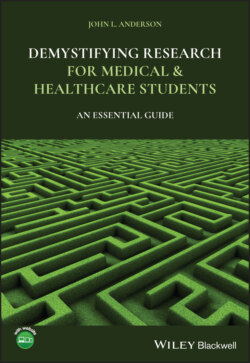Читать книгу Demystifying Research for Medical and Healthcare Students - John L. Anderson - Страница 42
To Sum Up
ОглавлениеFirst: you state clearly what you intend to do and why – including your hypotheses – if any. At this point, consider whether your study will be a single‐arm experiment or whether it will have more arms?
1 Then you decide who, or what, you want to include in your research, and how you will recruit them.
2 Next, if you have more than one arm, you should randomly allocate your research participants, or ‘subjects’ to the different groups.
3 You conduct the experiment and you note the results.
4 You analyse your results.
5 You disseminate your results by presenting the findings at conferences, or by publishing them in a book or in professional journals.
So, in Hiroto's and Seligman's work, their goals were clearly stated and linked to earlier work. They recruited an appropriate number (96) of psychology students and randomly allocated them to one of the three groups – the ‘control’, the ‘yoked control’, and the ‘helpless’ groups. They began the experiments by the ‘pre‐treatment’ helplessness testing/treatment. Then they tested the subjects' abilities to perform physical or cognitive tasks (performance on a shuttle‐box scenario, anagram testing, or discrimination testing). They measured the final performances of the three groups of subjects and finally they compared them. Then they published their findings and toured the world giving talks about their work before moving on to develop their work further. Nice work if you can get it!
Research is the art of the possible!
